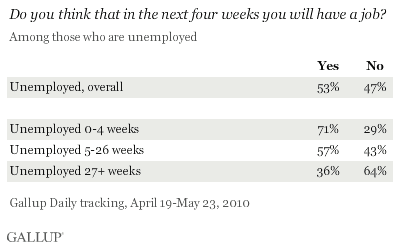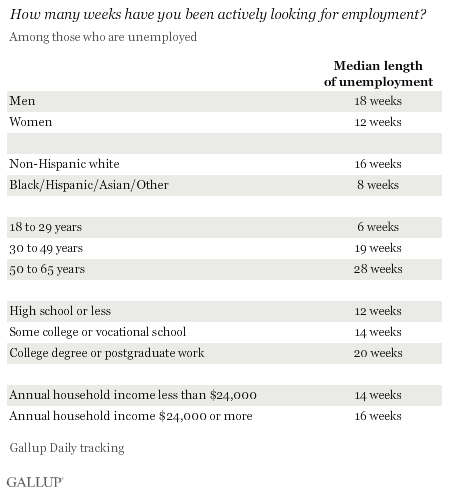WASHINGTON, D.C. -- Unemployed Americans' hopes for finding work in the next four weeks drop sharply as their length of unemployment increases, from 71% for those who have been unemployed less than a month to 36% among those unemployed for more than six months.

These results are based on April 19-May 23 interviews with 2,096 unemployed adults, aged 18 and older, conducted as part of Gallup Daily tracking. Gallup classifies respondents as unemployed if they are not working, are actively looking for work, and are available for work.
During this time, Gallup found that currently unemployed Americans have been actively looking for work for a median of 14 weeks, including 25% who have been doing so for a year or more. The majority of the unemployed (51%) have been out of work more than a month but less than a year.

Gallup's unemployment rate during this time frame was 9.5%, and it is not seasonally adjusted.
Older, Highly Educated Americans Unemployed Longest
Job seekers aged 50 to 65 report the highest median length of unemployment, at 28 weeks, while 18- to 29-year-olds report the shortest length of unemployment, at 6 weeks. Length of unemployment for men, non-Hispanic whites, 30- to 49-year-olds, and those with college degrees or postgraduate work also exceeds the median.

Bottom Line
Unemployment remains high and millions of Americans face long-term joblessness and the loss of hope that they will find work soon. Gallup will continue to track length of unemployment and will explore the physical and psychological effects of long-term unemployment in future articles.
Survey Methods
Results are based on telephone interviews with a random sample of 2,096 national adults, aged 18 and older, who are not working, are actively looking for work, and available for work, conducted as part of Gallup Daily tracking April 19-May 23, 2010. For results based on the total sample of national adults, one can say with 95% confidence that the maximum margin of sampling error is ± 2.6 percentage points. All reported margins of sampling error include the computed design effects for weighting and sample design.
Interviews are conducted with respondents on landline telephones and cellular phones, with interviews conducted in Spanish for respondents who are primarily Spanish-speaking. Each sample includes a minimum quota of 150 cell phone respondents and 850 landline respondents, with additional minimum quotas among landline respondents for gender within region. Landline respondents are chosen at random within each household on the basis of which member had the most recent birthday.
Samples are weighted on the basis of gender, age, race, Hispanic ethnicity, education, region, adults in the household, cell phone only status, cell phone mostly status and phone lines. Demographic weighting targets are based on the March 2009 Current Population Survey figures for the aged 18 and older non-institutionalized population living in U.S. telephone households. All reported margins of sampling error include the computed design effects for weighting and sample design.
In addition to sampling error, question wording and practical difficulties in conducting surveys can introduce error or bias into the findings of public opinion polls.
There are important methodological differences between Gallup daily tracking and the Current Population Survey (CPS) conducted by the Bureau of Labor Statistics. These differences include, but are not limited to, question wording, Gallup daily tracking versus CPS panel design, Gallup respondent level surveys versus CPS household level surveys, and BLS seasonal adjustments.
